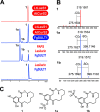Combinatorial Biosynthesis of Sulfated Benzenediol Lactones with a Phenolic Sulfotransferase from Fusarium graminearum PH-1
- PMID: 33239367
- PMCID: PMC7690957
- DOI: 10.1128/mSphere.00949-20
Combinatorial Biosynthesis of Sulfated Benzenediol Lactones with a Phenolic Sulfotransferase from Fusarium graminearum PH-1
Abstract
Total biosynthesis or whole-cell biocatalytic production of sulfated small molecules relies on the discovery and implementation of appropriate sulfotransferase enzymes. Although fungi are prominent biocatalysts and have been used to sulfate drug-like phenolics, no gene encoding a sulfotransferase enzyme has been functionally characterized from these organisms. Here, we identify a phenolic sulfotransferase, FgSULT1, by genome mining from the plant-pathogenic fungus Fusarium graminearum PH-1. We expressed FgSULT1 in a Saccharomyces cerevisiae chassis to modify a broad range of benzenediol lactones and their nonmacrocyclic congeners, together with an anthraquinone, with the resulting unnatural natural product (uNP) sulfates displaying increased solubility. FgSULT1 shares low similarity with known animal and plant sulfotransferases. Instead, it forms a sulfotransferase family with putative bacterial and fungal enzymes for phase II detoxification of xenobiotics and allelochemicals. Among fungi, putative FgSULT1 homologues are encoded in the genomes of Fusarium spp. and a few other genera in nonsyntenic regions, some of which may be related to catabolic sulfur recycling. Computational structure modeling combined with site-directed mutagenesis revealed that FgSULT1 retains the key catalytic residues and the typical fold of characterized animal and plant sulfotransferases. Our work opens the way for the discovery of hitherto unknown fungal sulfotransferases and provides a synthetic biological and enzymatic platform that can be adapted to produce bioactive sulfates, together with sulfate ester standards and probes for masked mycotoxins, precarcinogenic toxins, and xenobiotics.IMPORTANCE Sulfation is an expedient strategy to increase the solubility, bioavailability, and bioactivity of nutraceuticals and clinically important drugs. However, chemical or biological synthesis of sulfoconjugates is challenging. Genome mining, heterologous expression, homology structural modeling, and site-directed mutagenesis identified FgSULT1 of Fusarium graminearum PH-1 as a cytosolic sulfotransferase with the typical fold and active site architecture of characterized animal and plant sulfotransferases, despite low sequence similarity. FgSULT1 homologues are sparse in fungi but form a distinct clade with bacterial sulfotransferases. This study extends the functionally characterized sulfotransferase superfamily to the kingdom Fungi and demonstrates total biosynthetic and biocatalytic synthetic biological platforms to produce unnatural natural product (uNP) sulfoconjugates. Such uNP sulfates may be utilized for drug discovery in human and veterinary medicine and crop protection. Our synthetic biological methods may also be adapted to generate masked mycotoxin standards for food safety and environmental monitoring applications and to expose precarcinogenic xenobiotics.
Keywords: Fusarium; combinatorial biosynthesis; phenolic sulfotransferase.
Copyright © 2020 Xie et al.
Figures




References
-
- Schmitt-Hoffmann A-H, Kato K, Townsend R, Potchoiba MJ, Hope WW, Andes D, Spickermann J, Schneidkraut MJ. 2017. Tissue distribution and elimination of isavuconazole following single and repeat oral-dose administration of isavuconazonium sulfate to rats. Antimicrob Agents Chemother 61:E01292-17. doi:10.1128/AAC.01292-17. - DOI - PMC - PubMed
-
- Bohmdorfer M, Szakmary A, Schiestl RH, Vaquero J, Riha J, Brenner S, Thalhammer T, Szekeres T, Jager W. 2017. Involvement of UDP-glucuronosyltransferases and sulfotransferases in the excretion and tissue distribution of resveratrol in mice. Nutrients 9:1347. doi:10.3390/nu9121347. - DOI - PMC - PubMed
Publication types
MeSH terms
Substances
Supplementary concepts
Grants and funding
LinkOut - more resources
Full Text Sources
Miscellaneous
